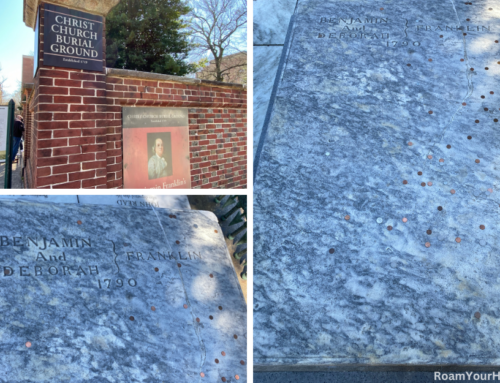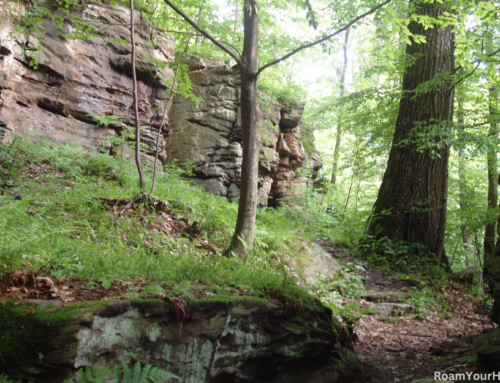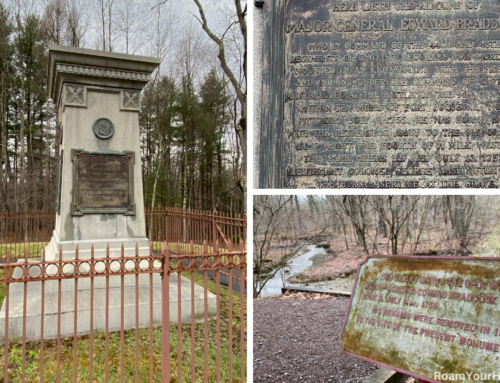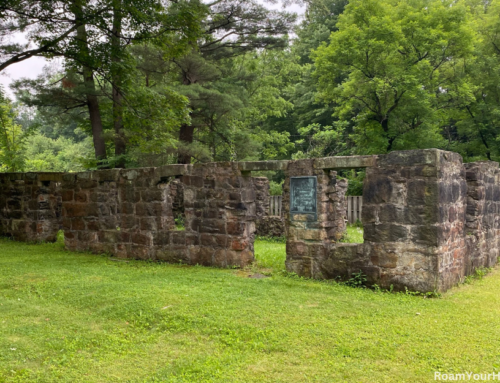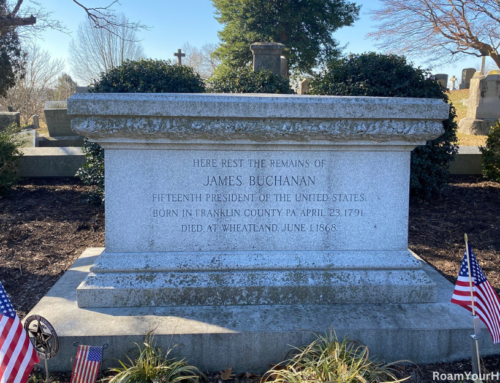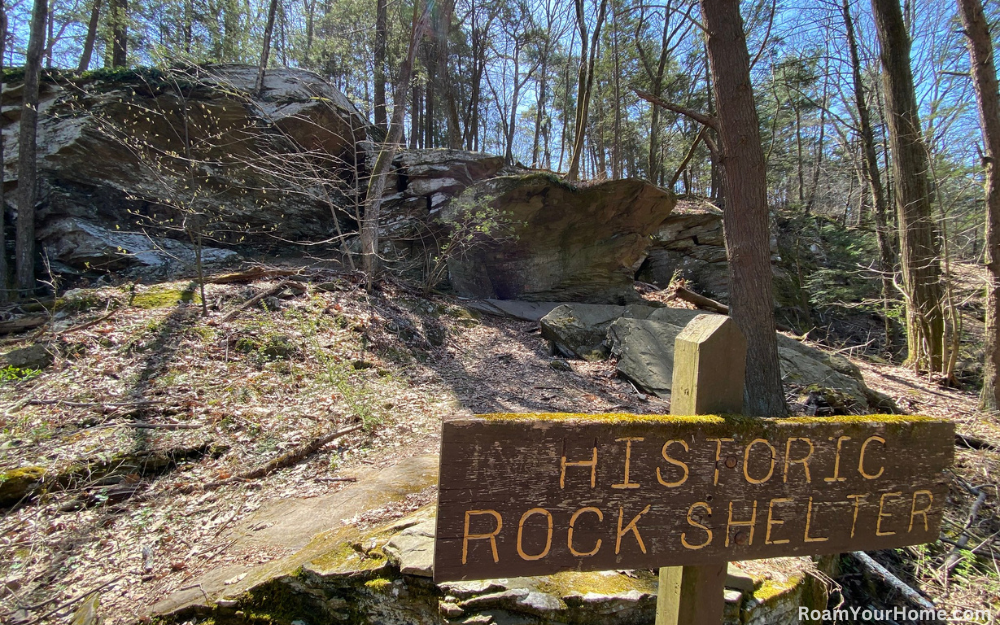
Visit Frances Slocum State Park and a 250 year old kidnapping site
Frances Slocum State Park is located in eastern Pennslyvania’s Luzerne County. It’s a short drive from Scranton and Wilkes Barre. The more than 1,000-acre park has a wide variety of outdoor recreation that attracts people from around the Keystone State and beyond. Boating, hiking, and camping, there is something for everyone… including history lovers.
Visitors to the park can visit the historic rock shelter where Frances Slocum spent her first night of captivity after being kidnapped by Indians. The park is named after Frances Slocum and offers a piece of uniquely American history.
Frances Slocum Kidnapping
Frances was about four years old when her Quaker family migrated west to Pennsylvania’s Wyoming Valley from Warwick, Rhode Island. Soon after the family arrived, the Revolutionary War came with the Battle of Wyoming, also known as the Wyoming Massacre. On July 3. 1778, more than 350 American men, women, and children in the area were slaughtered by the British and their Iroquois allies. The Slocum family survived and relied heavily on their pacifist Quaker faith and good relations with natives to keep them safe. For about four months, this was the case. Then, on a cold day in early November 1778, three Delaware Warriors burst into the Slocum home in broad daylight, kidnapping 5-year-old Frances. She had this to say many years later about the day she was taken.
“Three Delaware Indians came suddenly to our house. They killed and scalped a man by the door. A boy ran into the house, and he and I hid under the staircase. The Indians came into the house and upstairs. They took some loaf sugar and some bundles of other things. They carried us through the bushes. I looked back but saw no one except my mother. They carried us over the mountains -it seemed to me a long way to a cave where they had left their blankets and some other things. There was a bed of leaves and there we lay all night. We reached this place while it was yet light. I was very tired, and I lay down on the ground and cried until I fell asleep.”
The following day, they left early, and that would be the last time Slocum ever saw her home. Of the journey, writing, “The Indians were very kind to me; when they had anything to eat, I always had the best; when I was tired, they carried me in their arms; and in a short time, I began to feel much better and stopped crying.”

Frances Slocum gets adopted into a tribe
Frances would be adopted by a childless Delaware chief and his wife. They renamed her Weletawash after their late daughter. “When the Indians thus lose all their children, they often adopt some new child as their own and treat it in all respect as their own,” Frances recalled. “This is why they often carry away the children of white people.”
While walking through the woods one day, Weletawash encountered a Miami Warrior named Shepoconah, who was injured in battle. She took the brave worrier to her adopted parent’s home and nursed him back to health. She would go on to marry him, giving birth to four children, of which two daughters would live to adulthood. After the marriage, Frances joined Miami and took the name Maconaquah or Little Bear. Her travels would take her through Niagara Falls, Detroit, and then ultimately to near Fort Wayne, Indiana, after the War of 1812. “This was now my home, and we lived there for thirty years, I suppose,” Frances said.
For 59 years, Frances Slocum lived amongst the Native Americans without ever speaking to her family. In 1835, an Indian Trader was visiting Slocum’s Miami village. The trader, named Colonel George Ewing, spoke the Miami language fluently. During his visit, he talked to Frances, who, by this point, had long forgotten how to speak English. Frances told him she was a white woman who, as a small child, was kidnapped. She told Ewing her white family’s name was Slocum, and they were Quakers farmers. In an attempt to reunite Frances with anyone still living in her family, he sent a letter to a Pennsylvania newspaper asking if someone had a relative kidnapped by Indians during the Revolutionary War.
Slocum Reunited with family
Two years later, Frances’s brothers Issac and Joseph and her sister Mary traveled to her village in Indiana to find out if this woman Ewing described in his letter was indeed Frances. Upon their arrival, the now-elderly siblings realized that the old woman sitting in front of them was, amazingly, their long-lost sister. They were thrilled to see her after all these years but shocked by her. The young girl they knew as Frances did not remember her first name, spoke through an interpreter, and was deeply assimilated into Miami culture. Her siblings wanted her to come home with them, but she refused. Saying she would remain with her Miami family. Returning to the white world would be like a “fish out of water,” she said. While Frances refused to leave, she did agree to her family’s request to have her portrait painted.
Her family commissioned English artist George Winter to paint a portrait of Frances. His portrayal of her would go on to become one of his best-known works. Winter’s described her as he painted later in his journal. “Frances Slocum’s face bore the marks of deep-seated lines. The muscles of her cheeks were like corded rises, and her forehead ran in almost right angular lines. There was an indication of no unwanted cares upon her countenance beyond time’s influence, which peculiarly marks the decline of life. She bore the impress of old age without its extreme feebleness. Her hair, which was evidently of dark brown color, was now frosted. Though bearing some resemblance to her family, yet her cheekbones seemed to bear the Indian characteristic in that particular face broad, nose somewhat bulby, mouth perhaps indicating some degree of severity. In her ears she wore some few ‘ear bobs’.”
Frances Slocum passed away on March 9, 1847, at her village along the banks of the Mississinewa River in Indiana. She was 74 years old.
Visiting Frances Slocum State Park
Frances Slocum State Park in northeastern PA is a beautiful place to spend some time outdoors. It is a short and easy hike to that “cave” where she cried herself to sleep more than 240 years ago. I got there mid-afternoon in early summer. A few cars were in the parking lot, but everyone seemed to be fishing. The trail was empty. As I climbed a gentle slope to the shelter, a few white-tailed deer sprang away. Once I got there, I relaxed for a bit on a nearby rock. Sitting quietly, imagining how terrified that 5-year-old girl must have been 250 years ago. After about 15 minutes, I got up, took a few more pictures, and headed down the trail to the lake while wondering how much the land had changed in the centuries that had passed.
Things to do at the Park
The horseshoe-shaped Frances Slocum State Park Lake is extremely popular with anglers and for watersports. In the summertime, you rent canoes and kayaks and spend the day on the lake. You can spend as little as a few hours exploring the park or several days. There is a nice campground to pitch a tent. No matter how long you decide to spend, a trip to Frances Slocum State Park is walking back through time and tracing the footsteps of a piece of little-known American history.



